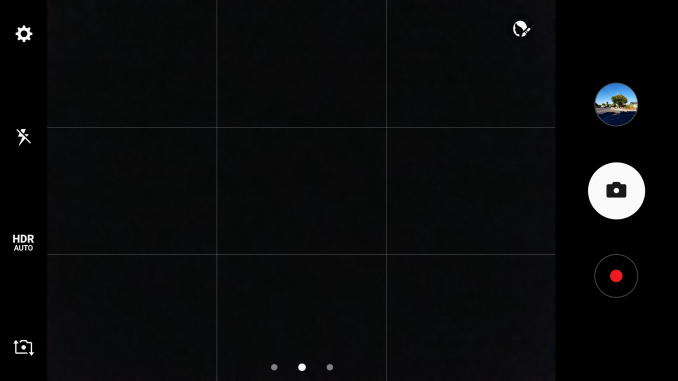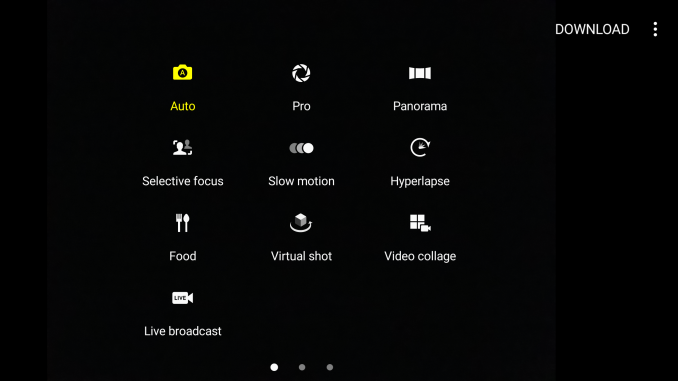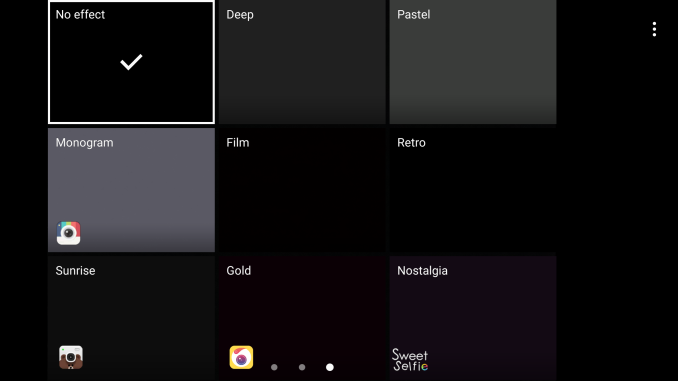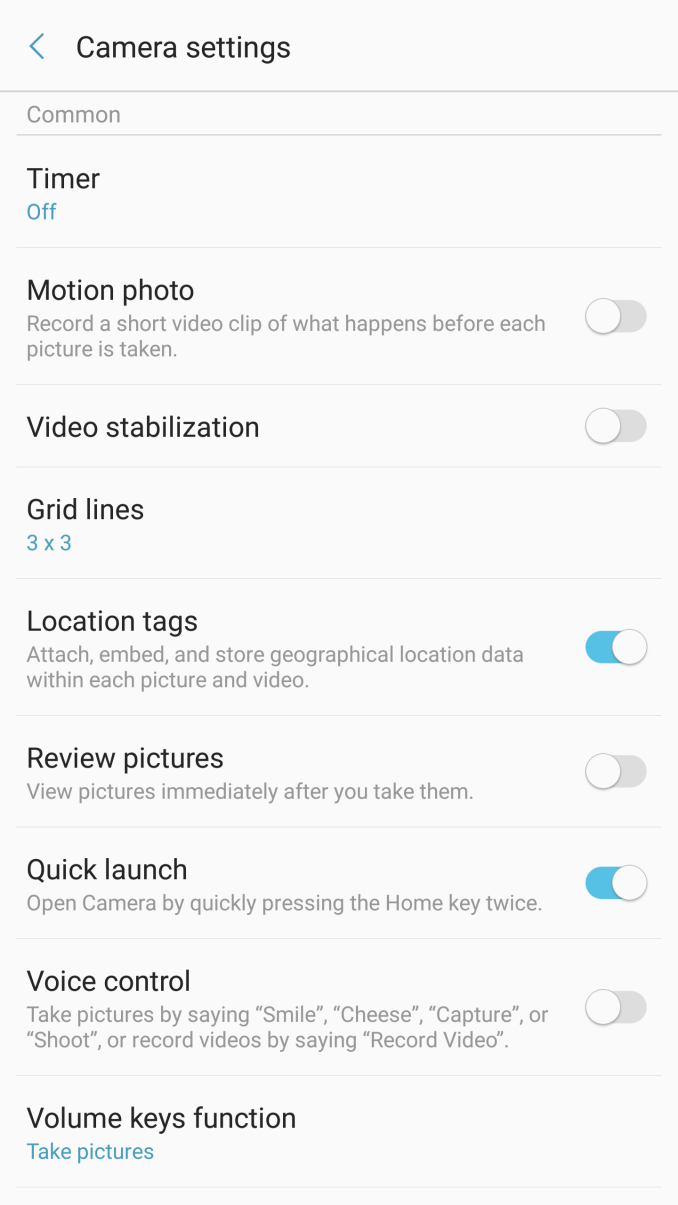The Samsung Galaxy Note7 (S820) Review
by Joshua Ho on August 16, 2016 9:00 AM ESTCamera Architecture
In general, camera has become probably the single biggest point of differentiation between smartphones at this point. As smartphones are often the only camera that most people carry on a day to day basis, the rear camera on a smartphone really cannot be a disappointment relative to the competition. While we can talk about how much a front-facing camera matters in terms of quality, it’s pretty safe to say that for photos and videos that are worth saving will be taken with the rear-facing camera.
While post-processing and a number of other factors are going to have a huge impact on the overall camera experience, the foundation that makes it possible to deliver a great camera is always going to start at the hardware.
| Samsung Galaxy Note Cameras | ||||
| Galaxy S6 Galaxy Note5 |
Galaxy S7 Galaxy Note7 |
|||
| Front Camera | 5.0MP | 5.0MP | ||
| Front Camera - Sensor | Samsung S5K4E6 (1.34 µm, 1/4") |
Samsung S5K4E6 (1.34 µm, 1/4") |
||
| Front Camera - Focal Length | 2.2mm (22mm eff) | 2.1mm (21mm eff) | ||
| Front Camera - Max Aperture | F/1.9 | F/1.7 | ||
| Rear Camera | 16MP | 12MP | ||
| Rear Camera - Sensor | Sony IMX240 Samsung S5K2P2 (1.12 µm, 1/2.6") |
Sony IMX260 Samsung S5K2L1 (1.4 µm, 1/2.6") |
||
| Rear Camera - Focal Length | 4.3mm (28mm eff) | 4.2mm (26mm eff) | ||
| Rear Camera - Max Aperture | F/1.9 | F/1.7 | ||
It’s probably not any surprise that the Galaxy Note7 has the same exact camera setup as the Galaxy S7, but in case it was ever in doubt it shouldn’t be now. Given the similar camera setup I don’t think that there’s a ton of difference to be expected between the two phones but things like software algorithms can and do change with time so it’s important to not just immediately write off the Galaxy Note7 or assume it’s immediately going to be award-winning. It’s worth reiterating here that the dual pixel system likely incurs a sensitivity penalty as in order to implement the dual pixel system each pixel must have a physical light barrier as you need a microlens and a barrier to make light from the same object converge on two separate photodiodes so the amount of light collected is inherently going to be less than no barrier and a single photodiode per pixel. I’m also curious to know whether any quantum effects appreciably change sensitivity here as if a single pixel is a 1.4 micron square then each photodiode has area similar to a 1-micron pixel. With that said we can move on to the one major change highlighted by Samsung, namely the user experience.
Camera UX
One of the major points highlighted in the launch event was that the camera application was completely redesigned. In addition to a fairly subdued icon that better fits the color palette for Android in general, the UI itself is a bit cleaner out of the box.
Right away when you open the camera app the most apparent thing is that the number of icons has been reduced. Instead of a dedicated mode button it’s now a swipe, and the same is true of the effects button. There’s also no more timer or resolution button on the screen by default, and the button to hide the various settings buttons has been eliminated entirely. It’s also worth mentioning that the button to change between cameras has been moved and a gesture to do the same thing has been added so you can simply swipe up or down to switch between cameras. Samsung also continues to shut off the camera after a few minutes automatically which is good if you’re a normal user but annoying if you’re trying to set up a shot of an ISO chart with a tripod.
Other than these changes almost nothing else really changes. There are some extra toggles like shape correction in the settings overflow and RAW output is now hidden under Picture Size for the rear camera but nothing else is really notable. I don’t really have anything else to say here that’s new, and I would refer to the Galaxy S7 Part 2 review if you are otherwise unfamiliar with Samsung’s camera application. As both perform identically as far as focus and capture speed goes subjectively we’ll temporarily forgo these results in favor of timeliness for this review.















202 Comments
View All Comments
Axiomatic - Wednesday, August 17, 2016 - link
My cube mate over the wall from me got the Note 7 today. His immediate comment to me was, "well it performs better with Nova Launcher than Touchwiz."trparky - Wednesday, August 17, 2016 - link
When you have to replace stuff on your phone to get acceptable performance, there's something wrong.silverghozt - Wednesday, August 17, 2016 - link
Are the photos from the Note 7 worse than the Note 5? Can you please compare. I'm astounded that the HTC 10 is taking better images.BoyBawang - Thursday, August 18, 2016 - link
Dear Anandtech,Please do a battery life test of the lower screen resolution settings. If the result is significant, I'll immediately permanently put it to 1080p without second thoughts the moment I have the device. I don't care if the mutant pretenders say that they can distinguish the difference.
thanks
lebigamaca - Thursday, August 18, 2016 - link
It looks like you got the size of the rear camera pixels in reverse. Both are 1/2.6 inch so the 16 megapixel should have smaller pixels than the 12 megapixel.skrewler2 - Thursday, August 18, 2016 - link
it would have been nice to see a picture of the s7 edge and note7 side by side or stacked on top of each other so we could get an idea of how much bigger the note isaryonoco - Friday, August 19, 2016 - link
Does the phone ship with the latest Android Security Patch level?Has the manufacturer committed to providing security patches on a timely basis?
Has the manufacturer committed to providing Android upgrades for X number of year?
Why are such basic questions that affect the usability and viability of a phone ignored by AnandTech? We don't all buy new phones every 6 months. Some of us are holding on to our phones for 24 months or longer. The question "will my phone receive OS updates during its lifetime" is a very valid question that AT pays no attention to.
Similarly we have paragraphs dedicated to the PMIC and various ICs in the phone, paragraphs dedicated to seeing if the phone drops a frame here or there, but no attention paid to the fact that the phone ships with unpatched remote root vulnerabilities.
Anandtech's reviews are becoming less and less relevant. Sure, it's cool to know what IC is doing what in the phone, but it's absolutely irrelevant to its day to day use. Knowing if the OEM is going to supply OS updates and security updates in a timely manner very much matters!
tamalero - Friday, August 19, 2016 - link
As someone who changes cell phones once every 3 or so years.. I'm pissed the current trend of copying Apple and their non changeable battery.Worse when Samsung no longer seems to produce older batteries to force to upgrade.
Not exactly a fan to be forced to for 500+ USD for a throwaway phone.
tamalero - Friday, August 19, 2016 - link
errata.. "not exactly a fan of being forced to FORK 500+ USD for a throaway phone every year"name99 - Friday, August 19, 2016 - link
"Despite all of this, there seems to be a general disappointment with smartphones."Come on Joshua, where do you drag up this nonsense?
There is a tiny fraction of internet whingers, hyperactive fools with the attention-span of 5-year olds and generally the technological to match, that are "disappointed".
Meanwhile in the real world, people are using their phones more than ever --- have you SEEN what a group of public people waiting around (think airport, restaurant, bus) looks like these days?
People in the saturated wealthy nations continue (so far, as of the most recent data) to buy phones on the reliable two-year-update cycle --- and why not? This year's phones are faster than those of two years ago, with more RAM, faster flash, better radios,nicer screens.
Meanwhile people in the non-wealthy world continue to be grateful for the ever falling prices, and enjoy moving on to their first smart phone.
You are not in the business of click-bait or insane interest advocacy; you are in the business of tech journalism. You don't need to write to such stupid sentences; you;re better than that; and the market you're discussing deserves better.
And starting with a stupid premise leads to what are factually flat out factually incorrect statements like "People are increasingly finding it hard to justify phones like the HTC 10 or Galaxy S7 with competition from..."
HOW are people finding it hard to justify phones like the S7? Everyone knows I'm an Apple fan, but I'm also tuned into reality, and the reality is that the S7 has sold pretty damn well, (as far as I can tell perhaps 20% better than the S6).
Look it's probably true that one day we'll hit enough of a wall in phone tech that the upgrade cycle WILL slide, and consumers WILL be massively over-served by phones. But let's not pretend that that prediction has already arrived.
Part of the problem is that these reviews operate with a broken context. It makes sense to compare against last years model, but it also makes sense to compare against the model from two years ago because THAT is where the audience for this product is. Complaining that it won't excite the community it isn't TARGETED AT (ie the owners of last-years model) is just stupid.